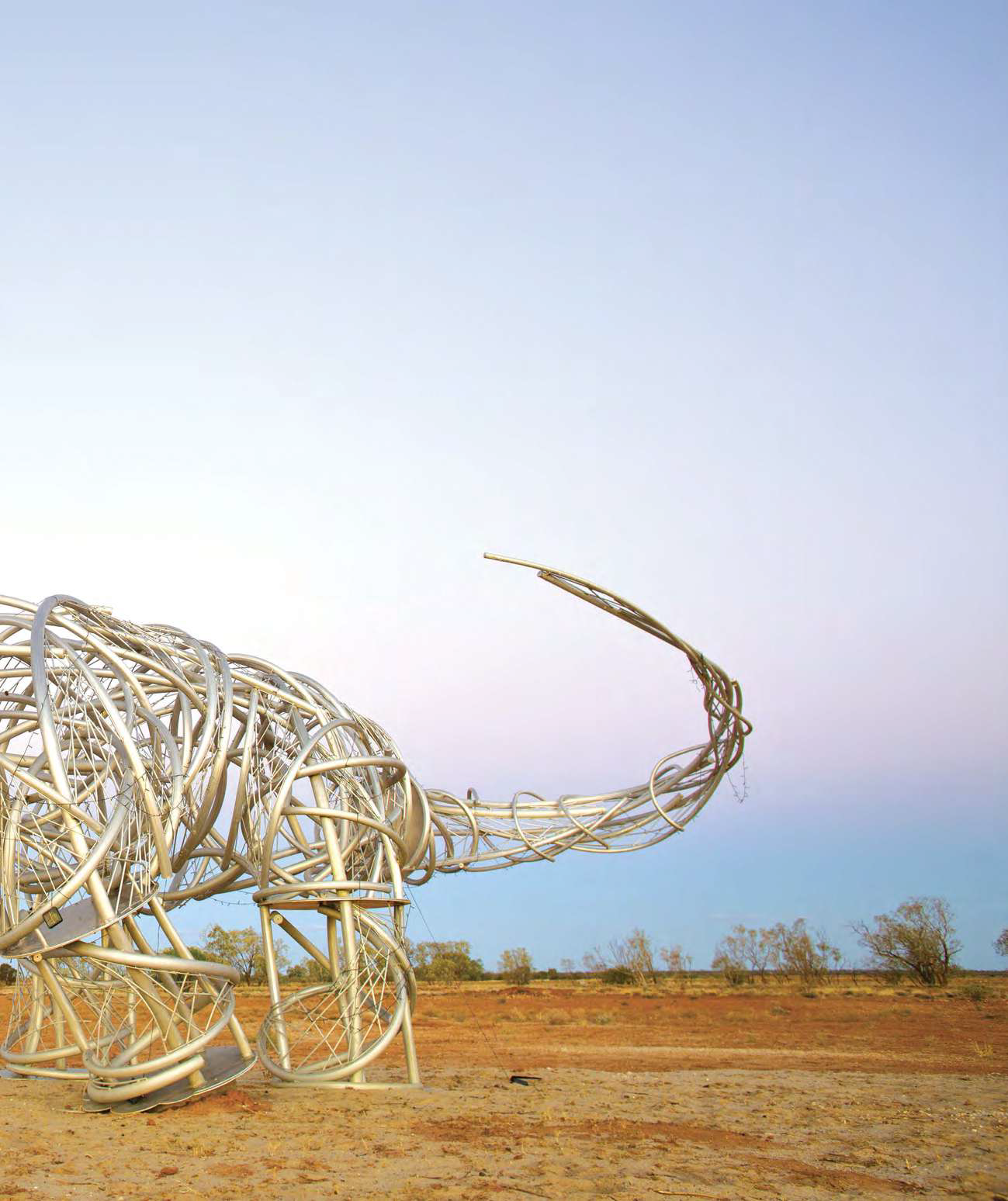
For my son, Finn, our Gold Coast stay was always going to be the highlight of our journey across southern Queensland. What pre-teen kid wouldn’t want a beachside holiday incorporating one theme park after another? But it’s time to depart on our next leg to Birdsville.
In marketing speak, they call this route the Warrego Way, a 1600km journey west from Brisbane along blacktop roads for all but the last 270km. We initially make a beeline for Toowoomba, passing through the volcanic black soils of the Lockyer Valley before climbing the Great Dividing Range to Queensland’s garden city.
It’s our first visit to Australia’s second-largest inland city (behind Canberra) and there’s much to see and do. We love its neat, wide streets and stately Queenslanders. The Empire Theatre is a beautifully preserved example of turn-of-the-century architecture. Street art has flourished. And the many viewpoints along the escarpment rim make stopping here well worthwhile.
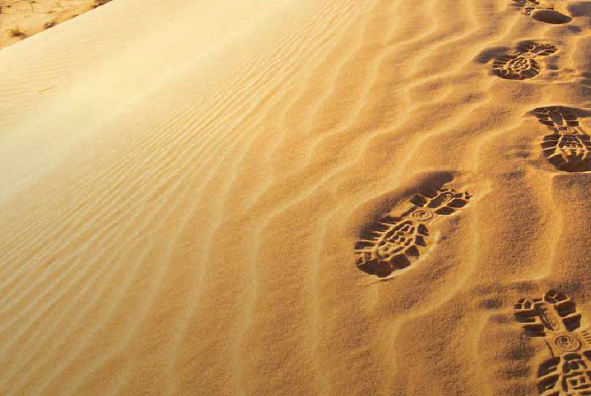
Watch your tracks follow you in the sand as you walk
We camp that evening out of town, parking our vehicle beside the historic Jondaryan Woolshed. It costs $27 for our choice of powered or unpowered sites alongside the Oakey Creek, with bedding also available in various cottages, cabins, and shearer’s quarters. The current woolshed was completed in 1861 and ranks as one of the largest in the country. At its peak, it held 3000 sheep beneath its galvanised iron roof.
The heritage listed woolshed has become a popular wedding venue and acts as a monument to the rich pastoral history of the Darling Downs region, which continues as far west as the Leichhardt Highway junction in Miles. The terrain through here is pancake-flat, passing by cotton fields and pulse and legume farms around Dalby and Chinchilla.
Chinchilla is best known for the Melon Festival, a riotous, weeklong occasion held every other year on the third Saturday in February.
The prevalence of temporary mining camps around Miles contrasts with the permanent displays at the town’s Historical Village Museum. The buildings and collections date from the 1860s to the 1950s and include wartime and colonial-era exhibitions. It’s a little quirky, too. The Shell House is said to be Australia’s largest private collection of seashells — ironic, given its location 300km from the ocean — and there’s a world-class lapidary display that includes petrified woods and precious gemstones, some of which are millions of years old.
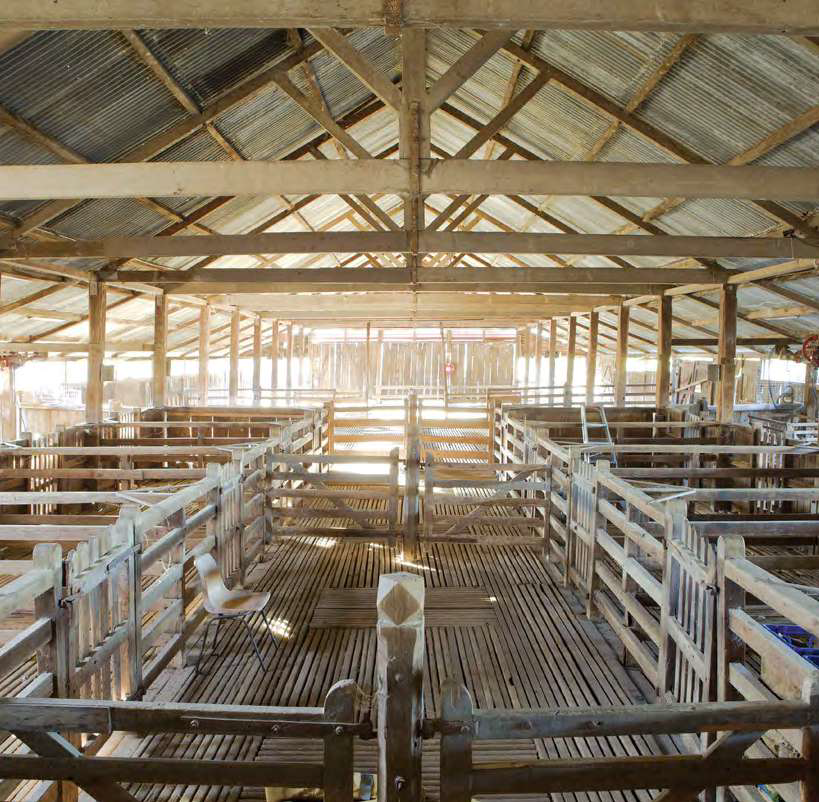
Inside the beautiful Jondaryan Woolshed
Roma is the administrative hub for gas and oil mining operations in the Surat Basin, which you can learn about in the Oil Patch Museum or during the Night Show Sunset Experience at The Big Rig. It’s also home to the largest agricultural saleyard in the southern hemisphere, and the twice-weekly cattle sales are a spectacle not to be missed. Visitor tours run every Tuesday and Thursday from 8.30am in the Bull Ring area. Bookings aren’t required.
My father-in-law, Bryan, has arranged to join us from here on in and we collect him from Roma’s not-so-bustling airport before slipping into our powered site for the night at the Villa Holiday Park down the road.
After stocking up on supplies early the following morning, we depart town for Mitchell. Bryan, a retired farmer, remarks how healthy the countryside appeared as he flew into Roma. Blue-shirted stockmen on quad bikes watch over cattle grazing by the roadside. Myall trees sprout beside the highway. Mitchell, however, is where many say that the outback begins. Towns are sparse and the countryside changes. Road trains towing empty livestock trailers return to Roma from further west.
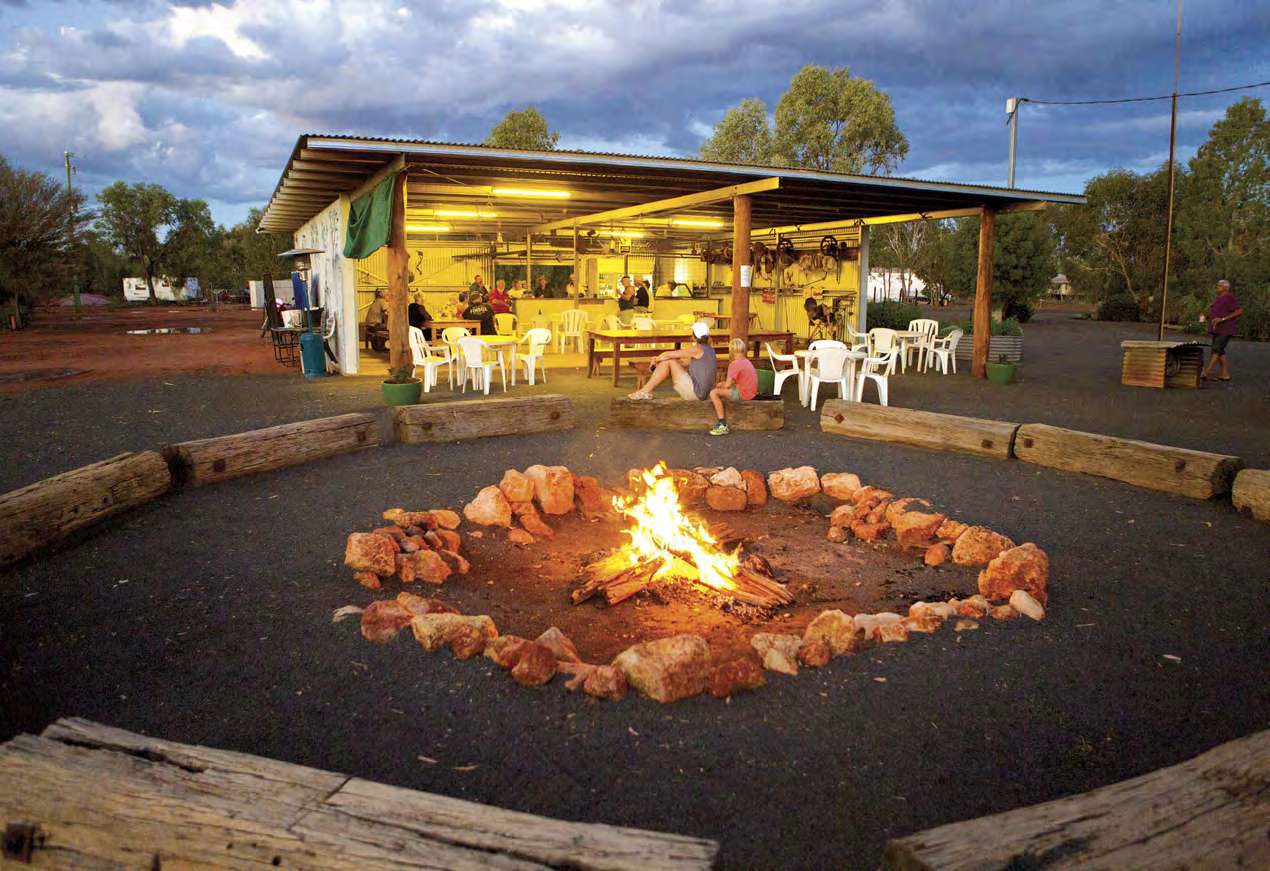
Unwinding at the bar at Evening Star Tourist Camp
It seems like this journey has already been filled with superlatives and in Mitchell, we find one more. Locals like to think of the Great Artesian Spa as the largest open-air spa in Australia. Two pools – one with a hydro chair for visitors with mobility issues – are filled with naturally heated artesian water, giving bathers the chance to soak in therapeutic, mineralised liquid gold. Mulga bushes dominate the landscape as we continue on to Morven, where the rebuilt Sadleir’s Waterhole hotel offers cheap camping. Oddly, though, we pass fields of scrub that have been bulldozed flat. With the Mulga roots still embedded in the soil, we’re later told that the cattle will graze on the leaves and the bushes will re-sprout. Considering the Armageddon-like destruction, it’s hard to imagine.
Legendary country musician Slim Dusty liked to croon about a girl who lived in Charleville, but ordinary Australians will appreciate less visceral pursuits. We call into the excellent Visitors Centre inside the old railway station building. Next door, but in the same building, is the Charleville Bilby Experience, where an afternoon tour enlightens us on the perilous plight of one of our most vulnerable native marsupials. And sticking with the superlative trend, Charleville’s Hotel Corones is listed as the biggest outback pub in the nation, allowing ample space for its resident ghost.
The night skies out here are some of the clearest in the land and one of the best places to see them is at Charleville’s Cosmos Centre. Not only can you spot the Southern Cross and view the Milky Way, but powerful telescopes allow visitors to see the rings of Saturn or view the sun up close.
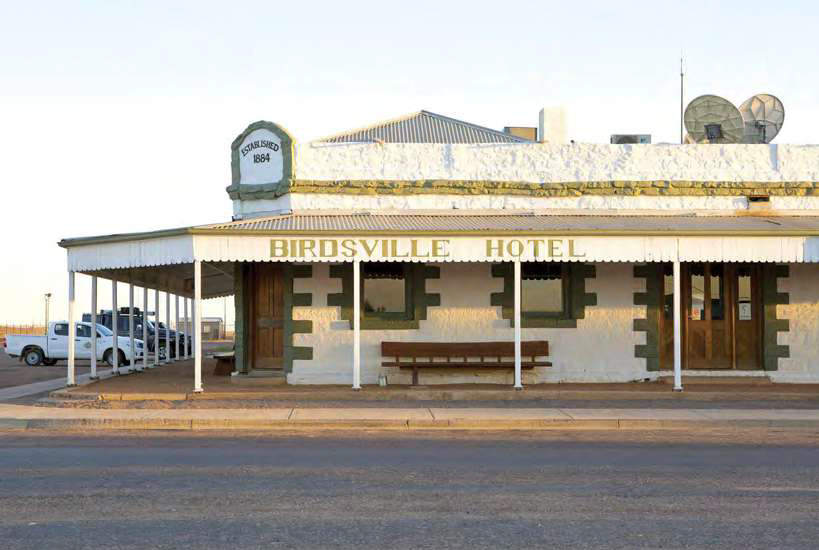
The historic Birdsville Hotel
Continuing the town’s astral flavour, we travel 8km north-west to the Evening Star Tourist Park, named after the planet Venus, itself visible above the tree line from the park’s bar and fire pit. The convivial atmosphere at the bar is what makes this place, along with the station’s owner Craig and his ever-helpful mother Shirley, who hoon around the camping area on quad bikes.
“She turned up here a few years ago and still hasn’t left,” says Craig.
The park is part of the 33,000-acre Thurlby Station, from which a 250-acre, pet-friendly section has been carved to accommodate up to 42 RVs on powered, drive-through sites at $40 per night. There’s a grassy, unpowered tent area ($25/site) and a camp kitchen next to the bar. Bushwalking trails snake through the mulga scrub and Craig hopes to open a predator-proof bilby enclosure at some stage.
It was indeed a starry night in Charleville, allowing for perfectly clear skies as we set off next morning. But it had rained for three nights straight prior to our arrival, with water still pooling by the side of the highway as we drove for the next two hours to Quilpie. There’s little in the way of livestock on the stony, red-soiled country out here, though emu sightings do increase.
We turn off the highway just before Quilpie to investigate Lake Houdraman on the unfortunately named Wanco Station. It’s possible to camp here, with tranquil powered and unpowered sites spread along the banks of the lake and in shady bush settings. Shower and toilet facilities near the homestead are available for $7.50 per person. Fully self-contained RVs can camp on the west side of the lake and there’s easy access for two-wheel drive vehicles.
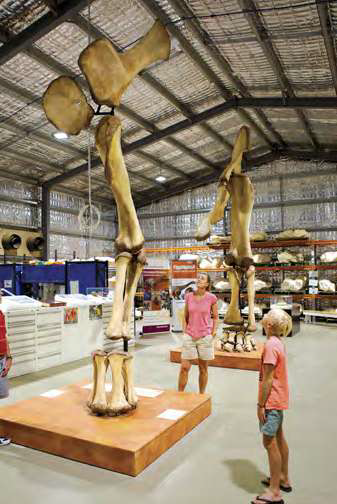
The Eromanga Natural History Museum
Being a Saturday, Quilpie’s main street is deserted, save for the supermarket remaining open. With little happening in town, curiosity drives us towards St Finbarr’s Catholic Church to check out its opalembedded altar before we continue on for another hour to Eromanga, the population of which is 45.
With the community charity barbecue (for the Royal Flying Doctor Service this time) held at the Eromanga Royal Hotel each Saturday, most of the town turns out and we manage to swell the population by 10 per cent. Sitting across from us are two staff members from the Eromanga Natural History Museum who had earlier escorted us on a tour of the facilities. The attraction at the museum is predominantly dinosaurs — titanosaurs, specifically — though there are megafauna specimens and butterfly collections as well. Eight titanosaurs were found in the region surrounding Eromanga, including Cooper, the largest dinosaur ever found in Australia. A partially completed skeletal replica of him occupies centre stage.
The Eromanga Motel & Caravan Park (powered $20, unpowered $10) has a swimming pool, making it a surefire winner in the eyes of Finn. And considering there’s an entrance sign into town proclaiming Eromanga to be Australia’s furthest town from the sea, any chance to go swimming should be grasped firmly with both hands.
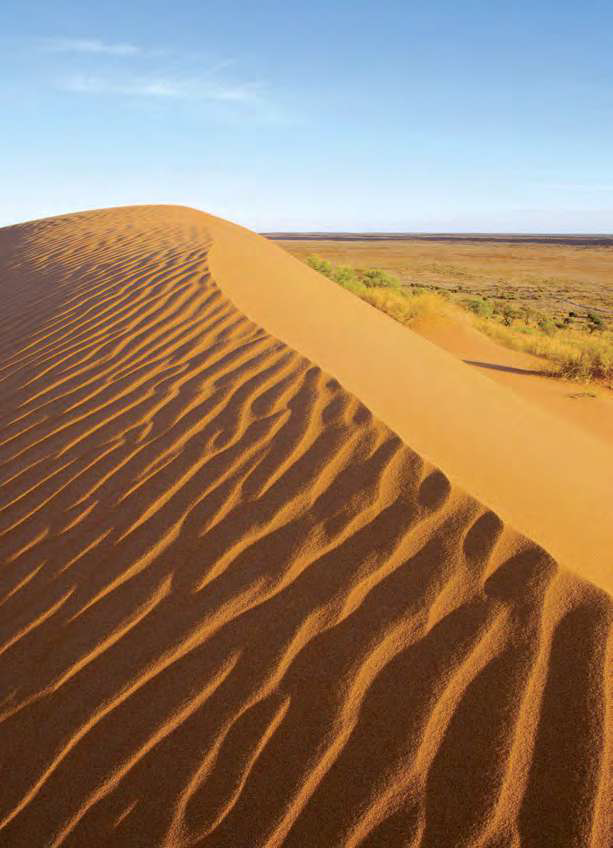
Dune walking and driving are exhilerating activities
From Eromanga, you can continue on to Innamincka in South Australia along sealed roads for all but the final 40km. Strictly speaking, Eromanga is not on the road to Birdsville but it isn’t far off it, adding just 80km to your odometer. Cooper the titanosaur is reason enough to add Eromanga to your itinerary.
It’s a 200km drive to the next town on the highway, Windorah, before we enter the Diamantina Shire — a government constituency that’s bigger than Tasmania but has just 300 permanent residents inhabiting Betoota, Bedourie, and Birdsville.
We leave blacktop roads behind once we link onto the Birdsville Developmental Road. High clearance vehicles are recommended, though the road is generally well-kept and occasionally sealed for light aircraft landings — just pray that one doesn’t coincide with your passing. If you’re particularly worried you can call ahead to the Birdsville Visitors Centre to check if you should proceed. I couldn’t foresee any problems when we did it, with the possible exception of having to change a tyre from punctures caused by sharp stones. It’s sage advice to deflate your tyres first.
Fortuitously, it’s ANZAC Day when we arrive in Birdsville and the annual two-up game is in full swing at the pub. Everyone who visits Birdsville calls into the pub for a meal, a drink or just a gander. A trip out to the Big Red is a must, as are visits to the racecourse and the bakery, where camel curry pies are the local specialty. You’re closer to Adelaide than Brisbane now, so travelling down the Birdsville Track to Marree is mighty tempting. That’s our next leg. But that, of course, is another story.
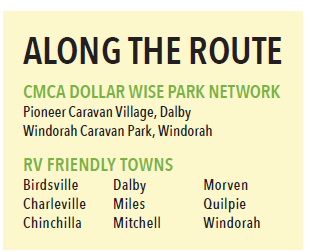
All prices correct at time of writing. Please confirm prior to arrival.
Category: Destinations
Written: Sun 01 Aug 2021
Printed: August, 2021
Published By: